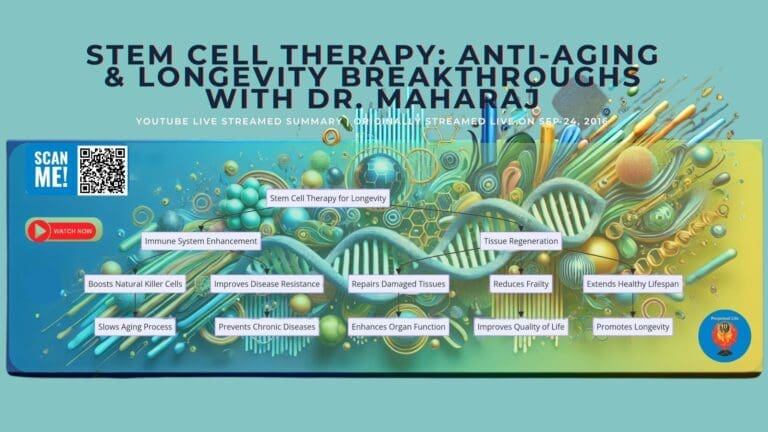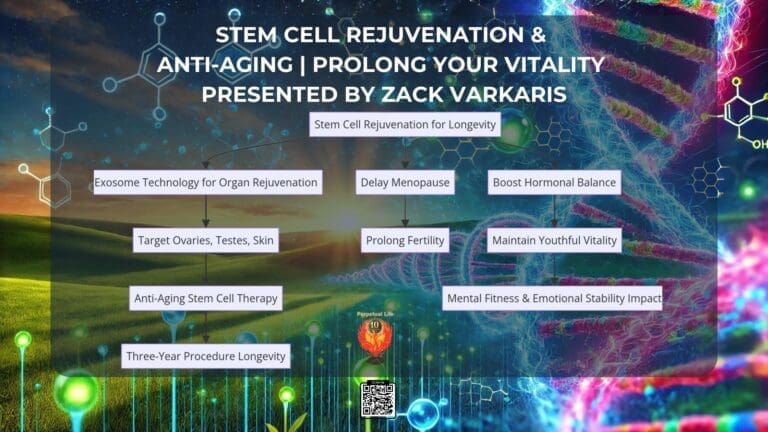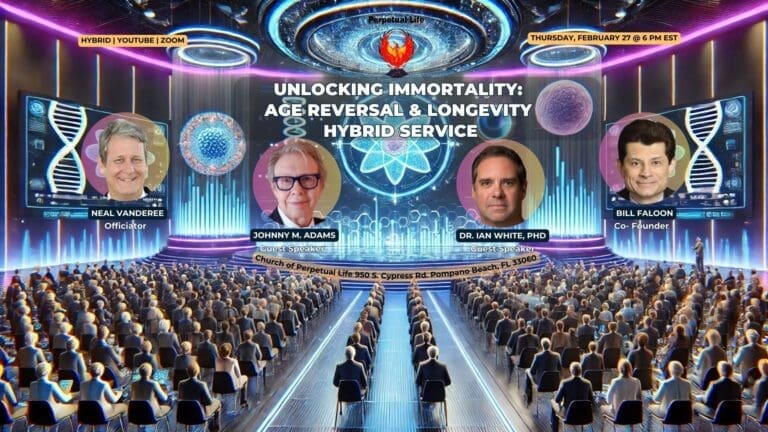Discover the latest in longevity science, anti-aging breakthroughs, and age reversal therapies. Explore plasma-based rejuvenation, gene therapy, and stem cell advances.
Unlocking the Secrets of Longevity & Age Reversal
On February 27, 2025, the Church of Perpetual Life hosted a groundbreaking hybrid service, bringing together leading experts in longevity science, regenerative medicine, and anti-aging breakthroughs. With cutting-edge presentations from Dr. Ian White, Bill Falloon, and Johnny Adams, this event unveiled some of the most promising age-reversal therapies that could reshape the future of human lifespan extension.
From the extraordinary longevity of the Greenland Shark to plasma-based rejuvenation and gene therapy breakthroughs, Perpetual Life February hybrid service provided deep insights into the science behind slowing, pausing, and even reversing aging. As new research emerges, it is becoming evident that aging is no longer an irreversible process—advancements in stem cell therapy, DNA repair, and exosome treatments are opening doors to an age-defying future.
Watch the replay of the live stream, tap link below.
Regenerative Medicine & Longevity Science: What We Learned
The expert speakers at the event shared vital updates on biomedical rejuvenation and anti-aging innovations aimed at reversing the biological clock. Key takeaways included:
- Plasma-Based Rejuvenation – Using young plasma infusions to restore cognitive and physical function.
- Gene Therapy & Longevity Genes – Exploring species like the Bowhead Whale and Greenland Shark for potential human application.
- Stem Cell & Exosome Therapy – Investigating how clotho proteins, cytokines, and Yamanaka factors can regenerate cells.
- FDA Trials & Biotech Advancements – The push to fast-track age-reversal clinical trials and bring treatments to the public.
Breakthroughs in Age Reversal & Longevity Science
1. Plasma-Based Rejuvenation: The Future of Anti-Aging
One of the most compelling discoveries in regenerative medicine is the role of therapeutic plasma infusions (TPI) in extending the health span. Johnny Adams highlighted studies showing that young plasma can enhance brain function, improve stamina, and reduce inflammation in older individuals.
Researchers have identified key biomarkers of aging that improve with blood plasma exchange, where old plasma is replaced with young, nutrient-rich plasma. Early clinical trials indicate that plasma-based rejuvenation may significantly delay the onset of neurodegenerative diseases and improve overall longevity.
2. Stem Cell & Exosome Therapy: Regenerating the Human Body
Dr. Ian White discussed the transformative potential of stem cell therapy in reversing aging at a cellular level. Exosomes and cytokines—tiny biological messengers—are proving to be game-changers in regenerative medicine, helping to repair damaged tissues, boost immunity, and stimulate youthful cell function.
In FDA-approved trials, scientists are experimenting with amniotic fluid-derived stem cells, which hold immense potential in treating age-related conditions such as arthritis, heart disease, and neurodegenerative disorders.
3. Genetic Reprogramming & Longevity Genes
Bill Falloon presented fascinating research on longevity genes found in nature’s longest-living species, including:
- Greenland Shark (400+ years) – Exceptional DNA repair mechanisms prevent aging-related damage.
- Bowhead Whale (200+ years) – Natural resistance to cancer and age-related diseases.
- Yamanaka Factors – Gene reprogramming techniques that reset aging cells to a youthful state.
By studying these species, scientists are working on gene-editing therapies that could one day allow humans to extend lifespan significantly.
Dr. Ian White – Stem Cells & Regenerative Medicine
- Aging is not necessarily a linear process and can be paused, slowed, or even reversed.
- Examples from nature (lobsters, jellyfish, and certain fish) demonstrate age resistance or reversal.
- Parabiosis experiments have shown that young blood factors can rejuvenate older mice.
- Exosomes, cytokines, and clotho protein are key components in regenerative medicine.
- Ongoing FDA-approved trials aim to explore amniotic fluid’s potential for reversing aging effects.
- Future approaches involve gene therapy and cellular rejuvenation to halt or reverse aging.
Bill Falloon’s Age Reversal Update
- Genomic Research: Scientists are studying long-lived species like the Bowhead Whale (268 years) and the Greenland Shark (over 400 years) to identify longevity genes.
- Gene Therapy Breakthroughs: Efforts to introduce longevity genes into human DNA via viral vectors and lipid nanoparticles.
- Yamanaka Factors: Research shows these gene-modifying factors can reset aging cells back to a youthful state.
- Plasma-Based Rejuvenation: Studies suggest infusing young plasma into older individuals can enhance health and lifespan.
- FDA Advancements: Scientists and biotech leaders are lobbying for FDA
- support to fast-track age-reversal therapies.
Johnny Adams on Biomarker-Driven Age Reversal Strategies
- Therapeutic Plasma Infusions (TPI): A method using young plasma to rejuvenate the body.
- Blood Plasma Exchange: The process removes old plasma and replaces it with young, nutrient-rich plasma.
- Biomarker Improvements: Plasma-based therapies improve reaction time, cognitive clarity, stamina, and blood pressure.
- Self-Experimentation Results: Many test subjects report reduced neuropathy, improved eyesight, and lower inflammation.
Future of Age Reversal: Combining plasma-based therapies with gene editing for optimal longevity.
Plasma infusions, particularly those using plasma from young donors, have been studied for their effects on both cognitive and physical function over time. Here are the key points based on research, expert discussions, and self-experimentation.
Cognitive Function Improvements
- Enhanced Memory & Clarity: Several individuals who underwent young plasma infusions reported better recall, faster thinking, and an overall improvement in mental clarity. Some noted increased verbal memory and improved ability to recall sequences of numbers.
- Better Decision-Making: Some test subjects experienced improved problem-solving skills and a greater ability to analyze and react quickly.
- Reduced Brain Fog: Many participants, including researchers themselves, reported feeling more mentally sharp, focused, and less fatigued after infusions.
- Potential Impact on Neurological Diseases: Plasma therapies have been explored as potential treatments for Alzheimer’s, Parkinson’s, and other cognitive disorders, as seen in human trials (e.g., the AMBAR study).
Physical Function Benefits
- Increased Stamina & Strength: Many participants reported higher energy levels, better endurance, and a reduction in physical fatigue.
- Improved Blood Pressure & Circulation: Some participants saw a lowering of high blood pressure, which suggests cardiovascular benefits.
- Reduced Inflammation & Faster Recovery: Plasma infusions help reduce inflammatory markers, which may lead to faster muscle recovery and better joint health.
- Enhanced Mobility & Reaction Speed: Studies and anecdotal reports indicated that mobility improved, particularly in grip strength, balance, and walking speed.
Conclusion
Plasma infusions, particularly with carefully screened young donor plasma, show significant promise in reversing cognitive decline and enhancing physical health. The benefits accumulate over time, making repeated treatments potentially more effective in maintaining youthful function.
The Greenland Shark (Somniosus microcephalus) is one of the longest-living vertebrates, with some individuals estimated to be over 400 years old. Scientists are studying its genetic adaptations to uncover potential applications for human longevity therapies.
Why Do Greenland Sharks Live So Long?
- Superior DNA Repair Mechanisms – Their cells show exceptional resistance to DNA damage, reducing age-related mutations.
- Slow Metabolism – Their extremely low metabolic rate minimizes cellular wear and oxidative stress.
Efficient Protein Maintenance – They possess unique chaperone proteins that prevent the accumulation of misfolded proteins, a key factor in aging. - Enhanced Immune System Genes – Their immune system remains active and adaptive for centuries, reducing age-related disease susceptibility.
Final Takeaway
While longevity genes from species like the Greenland Shark offer exciting possibilities, translating them into human therapies remains an ongoing challenge. Advances in gene therapy, regenerative medicine, and metabolic interventions could pave the way for human applications in the coming decades.
Plasma-based therapies have garnered significant attention in the field of regenerative medicine and anti-aging research. Below is an overview of notable scientific studies and developments in this area:
Plasma Infusion vs. Gene Therapy Comparison
| Category | Plasma Infusion | Gene Therapy |
| Mechanism of Action | Transfers young plasma into older individuals to introduce rejuvenating factors (e.g., exosomes, cytokines, clotho protein). | Alters genetic material to promote longevity by enhancing DNA repair, cellular rejuvenation, and activating Yamanaka Factors. |
| Primary Benefits | Improves cognitive function, reaction time, stamina, and lowers inflammation. | Resets aged cells to a more youthful state, potentially extending lifespan permanently after treatment. |
| Notable Studies | Parabiosis experiments in mice, human trials on plasma exchange (Ambrosia study, Stanford research). | Experiments using Yamanaka Factors in mice extended lifespan by 100%; early human trials are in progress. |
| Risks & Side Effects | Possible immune reactions, blood-borne disease transmission risks, and temporary benefits requiring repeated treatments. | Risk of cancer if uncontrolled cell division occurs, immune rejection, ethical concerns regarding genetic modification. |
| Regulatory Status | Limited FDA regulation; currently approved for some conditions but not explicitly for anti-aging. | More tightly regulated, requiring extensive clinical trials before FDA approval for human use. |
| Future Potential | Potential for increased adoption as a recurring rejuvenation therapy when combined with biomarker-driven protocols. | Breakthroughs could lead to one-time treatments for aging, reducing the need for continuous interventions. |
Timestamps for Key Sections ⏳
⏰ 0:00 – 5:00 → 🌹 Flower Sponsorship & Event Introduction
⏰ 5:01 – 20:00 → Introduction of Dr. Ian White, Bill Falloon, and Johnny Adams
⏰ 20:01 – 45:00 → Dr. Ian White’s Talk on Stem Cells & Regenerative Medicine
- Aging is not necessarily linear; it can be reversed
- Nature’s longevity secrets: Lobsters, jellyfish, and certain fish
- Parabiosis experiments: Young blood factors rejuvenating older mice
- Exosomes, cytokines, and clotho protein in regenerative medicine
- FDA-approved trials for amniotic fluid therapy
- Future of gene therapy and cellular rejuvenation
⏰ 45:01 – 1:10:00 → Bill Falloon’s Age Reversal Update
- Genomic Research: Studying long-lived species like the Bowhead Whale and Greenland Shark
- Gene Therapy Breakthroughs: Viral vectors and lipid nanoparticles for longevity
- Yamanaka Factors: Resetting aged cells to youthful states
- Plasma-Based Rejuvenation: Young plasma infusion benefits
- FDA advancements: Advocacy for fast-tracking age-reversal therapies
⏰ 1:10:01 – 1:40:00 → Johnny Adams on Biomarker-Driven Age Reversal Strategies
- Therapeutic Plasma Infusions (TPI) and Blood Plasma Exchange
- Biomarker improvements in reaction time, cognition, stamina, and blood pressure
- Real-world self-experimentation results: Neuropathy reduction, improved eyesight, and lower inflammation
- Future vision: Plasma therapies + gene editing
⏰ 1:40:01 – End → Dinner & Socialization
- Mediterranean-style meal to emphasize the role of nutrition in longevity
- Networking and discussions among longevity enthusiasts
Conclusion Diagram
Explanatory Q&A Section
1. How do plasma infusions impact cognitive and physical function over time?
Plasma-based rejuvenation therapies have demonstrated improvements in memory, stamina, and neural function, particularly in aging individuals. Studies suggest that younger plasma infusions may help restore youthful cellular activity by replenishing growth factors and reducing systemic inflammation.
2. What role do exosomes and cytokines play in reversing aging at the cellular level?
Exosomes act as cellular messengers, transporting regenerative signals to damaged cells. Cytokines play a role in reducing inflammation and enhancing repair mechanisms. These factors contribute to stem cell activity, improving overall cell health and longevity.
3. Are longevity genes from species like the Greenland Shark translatable to human therapy?
Research on Greenland sharks and Bowhead whales has identified unique genes linked to DNA repair and cellular resilience. Scientists are exploring ways to incorporate these genetic traits into human therapies via gene editing and synthetic biology.
Interactive Quiz
Test Your Knowledge!
Conclusion
As scientific advancements accelerate, the potential to extend human lifespan and enhance healthspan becomes more tangible. As Dr. Ian White stated, “Aging is a disease, and like all diseases, it can be treated.”





